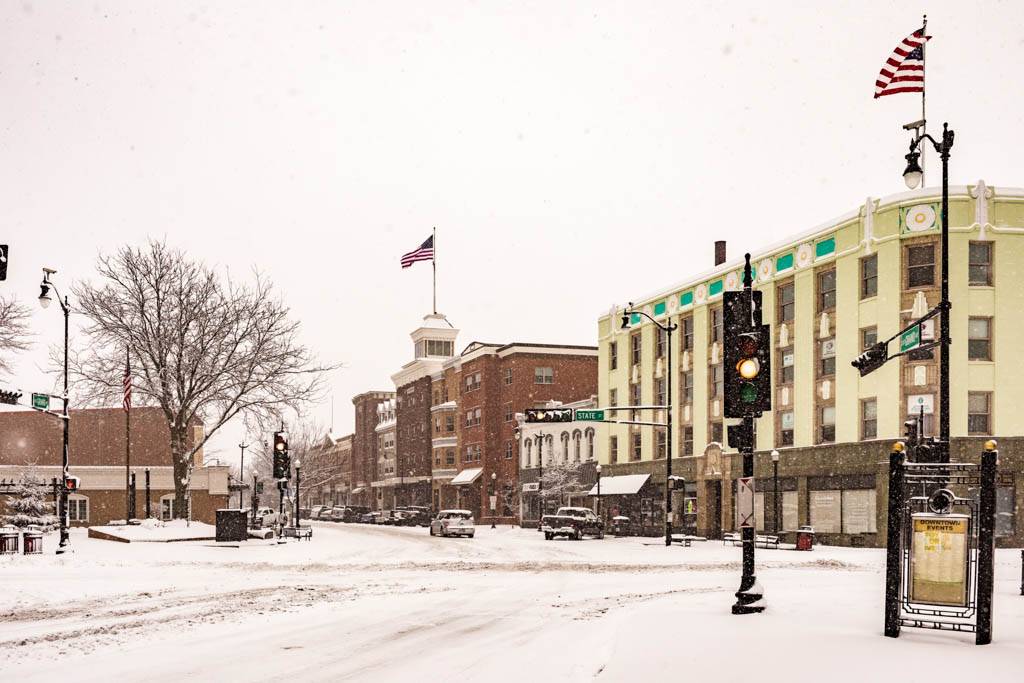
As winter blankets our cities in snow, the challenge of keeping streets and sidewalks clear becomes of paramount concern for municipalities, businesses, and residents alike. Effective snow removal is crucial for maintaining accessibility, ensuring safety, and minimizing disruptions caused by winter weather. This post explores the diverse strategies communities around Wisconsin employ to tackle snow removal, focusing on innovative practices and collaborative efforts that reflect the shared responsibility of this essential task.
The shared burden of snow removal
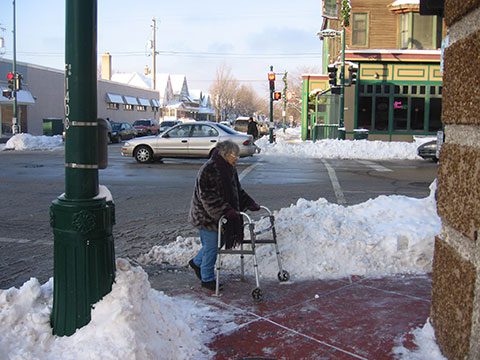
In West Allis, the Sanitation and Forestry Departments handle snow removal for the streets, alleyways, and municipal parking lots.
Across the board, snow removal is a collaborative endeavor, with responsibilities typically divided between city departments and business or property owners. In West Allis, for example, the division is clear: The Sanitation and Forestry Departments handle the streets, alleyways, and municipal parking lots; sidewalks fall under the purview of the business and property owners. This division not only ensures that thoroughfares and pedestrian pathways remain clear but also highlights the need for cooperation and communication to manage snowfall impacts on the community effectively.
In Beloit, the Public Works Department takes charge of downtown streets, while property owners are responsible for sidewalks. Many communities use this same delineation of duties, which assigns shared responsibility for keeping cities functional during winter.
In many cities, the approach to snow removal reflects a balance between efficiency and fairness. Municipalities strive to deploy resources where they are most needed, prioritizing main roads and emergency routes, while also considering the impact on local businesses and residents. Balancing these interests can pose challenges—in terms of both resources and expectations—especially during unexpected or severe weather events, which can strain even the most well-planned snow removal operations.
Policies guiding snow removal efforts
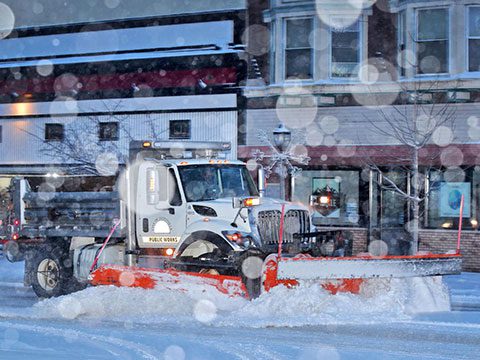
Janesville snow plow drivers deal with winter weather challenges.
Communities adopt various policies to streamline snow removal efforts. In Port Washington, businesses must shovel their walkways within 24 hours, a policy designed to ensure pedestrian safety and walkway accessibility. Similarly, Mayville takes a proactive approach to winter weather challenges by providing salt to business owners for de-icing. West Allis, meanwhile, has contracted with an external company for sidewalk snow clearing once 2 inches or more accumulates, prioritizing maintaining pedestrian access through crosswalks and strategic cut-throughs. This policy underscores the city’s commitment to keeping sidewalks accessible and demonstrates a proactive approach to winter weather challenges.
Janesville’s recent experience with large snow piles in its downtown area has sparked a reevaluation of its snow removal policies. Local business owners raised concerns about the fairness of snow removal billing and the impact of snow piles on business access, which led to discussions on how to improve the system. The city’s efforts to address these concerns, including reassessing snow pile sites and removing excess snow at its expense, represent a responsive and adaptive approach to snow management that balances efficiency with the needs of the business community.
Insights from various downtown communities
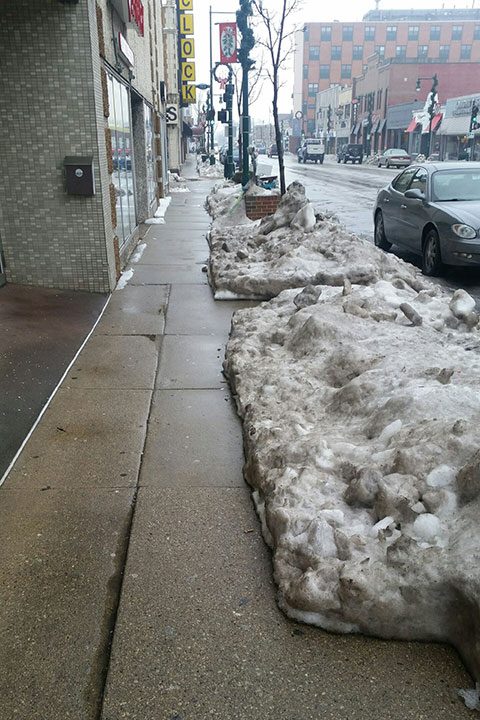
Challenges presented to both property owners and communities to keep both sidewalks and streets clear of snow.
Beloit and Port Washington:
Beloit’s approach, assigning responsibility to the city for streets and to property owners for sidewalks, is a common strategy. Port Washington adds the criterion of requiring businesses to clear sidewalks within a specific timeframe after snowfall, ensuring prompt removal.
Mayville and Darlington:
Mayville stands out by providing salt to business owners, facilitating their de-icing efforts. Darlington emphasizes the role of business owners and individuals in sidewalk snow removal, with the city regulating compliance through fines, reflecting a more enforcement-oriented approach.
Marshfield and Tigerton:
Marshfield introduces an innovative solution with sandboxes throughout the town for business owners’ use, a unique approach to de-icing. Tigerton, like many small communities, relies on village workers for plowing roads while expecting businesses to manage their sidewalks, incorporating varied scales of snow removal operations.
Eagle River and Fond du Lac:
Eagle River’s ordinance requires business owners to shovel snow into the streets by a certain time for Department of Public Works cleanup, a practice that necessitates coordination between businesses and city services. Fond du Lac, echoing this theme of cooperation, mandates sidewalk clearing by property owners, with the city focusing on streets and public spaces.
Lake Mills and Platteville:
Lake Mills and Platteville both emphasize the importance of business owner participation in sidewalk snow removal. The approach in Lake Mills also reflects a community spirit: Business owners often help each other, illustrating how communal efforts can enhance citywide snow management strategies.
Wausau, Two Rivers, Broadway District in Green Bay, and Chippewa Falls:
Wausau’s approach uses a provided, required contract for sidewalk snow removal for property owners. Two Rivers and Green Bay (Broadway District) highlight the importance of timely removal from sidewalks, with On Broadway Inc. in Green Bay engaging in a partnership with the Business Improvement District (BID) for managing snow in high-impact areas. Chippewa Falls relies on business owners for sidewalk snow removal, with a focus on efficiency and responsibility.
Case Studies: Community-driven snow removal programs
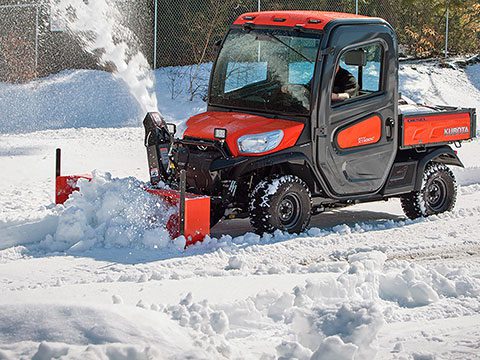
In Ripon, businesses receive snow removal services when 2 inches or more accumulates.
Ripon’s Proactive Snow Removal Program:
Ripon Main Street Inc. has implemented a snow removal program that serves as a model community-oriented initiative. For a reasonable fee, businesses receive snow removal services when 2 inches or more accumulates. This program runs seven days a week, including holidays, and aims to clear snow before the business day begins, aligning with city codes for cleared sidewalks. This initiative reduces the burden on businesses and furthers the collective goal of maintaining a safe, accessible downtown area.
West Allis’s Comprehensive Snow Management:
West Allis showcases a multifaceted approach to snow removal, assigning specific responsibilities to city departments and others to business and property owners. The city contracts with an external company for efficient sidewalk snow clearing, which includes one pass along the sidewalk, snow removal at crosswalks, and the creation of three cut-throughs per block, giving customers access to businesses without having to walk to the corner to get onto the sidewalk. This arrangement ensures that snow removal efforts are completed before businesses open, minimizing the impact of snowfall on daily operations and pedestrian access.
Janesville’s Snow Removal Reevaluation:
Janesville’s recent snow removal challenges highlight the need for ongoing dialogue and partnership between the city and the BID to ensure efficient, fair, and safe snow management practices. The collaborative efforts to address and rectify issues related to snow pile placement and billing for snow removal services reflect a commitment to improving downtown Janesville for businesses, residents, and visitors alike. The city’s willingness to reevaluate and adapt its snow removal policies in response to community feedback underscores the importance of flexibility and cooperation in urban snow management.
Embracing the snowy season with effective strategies
 The diversity of snow removal practices across different downtown communities offers valuable lessons in resilience, collaboration, and innovation. From the provision of salt and sandboxes to the strategic use of contractors and emphasis on timely sidewalk clearing, the featured communities showcase a range of approaches for keeping their streets and walkways safe and accessible during the winter months. As we navigate the winter season, these insights become guiding lights for communities seeking to enhance their snow removal efforts to ensure that life can proceed smoothly, even under a blanket of snow.
The diversity of snow removal practices across different downtown communities offers valuable lessons in resilience, collaboration, and innovation. From the provision of salt and sandboxes to the strategic use of contractors and emphasis on timely sidewalk clearing, the featured communities showcase a range of approaches for keeping their streets and walkways safe and accessible during the winter months. As we navigate the winter season, these insights become guiding lights for communities seeking to enhance their snow removal efforts to ensure that life can proceed smoothly, even under a blanket of snow.
